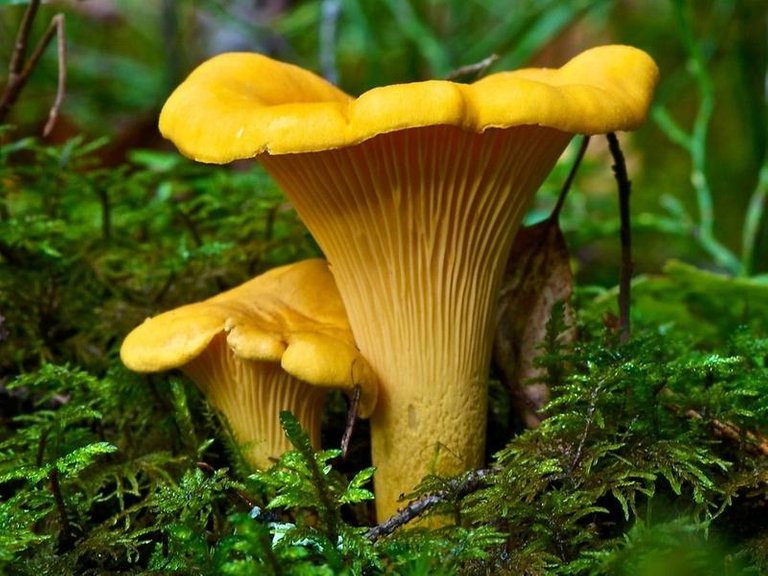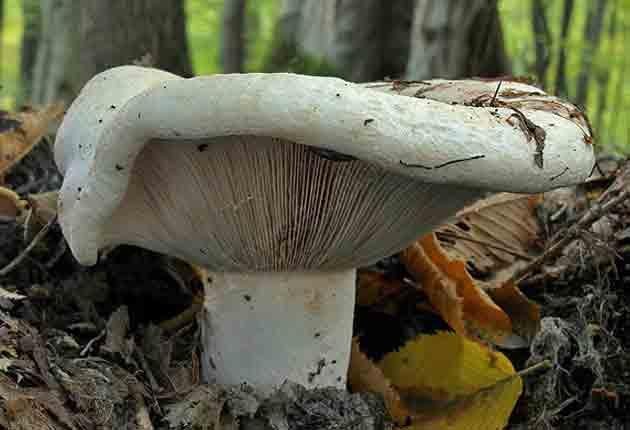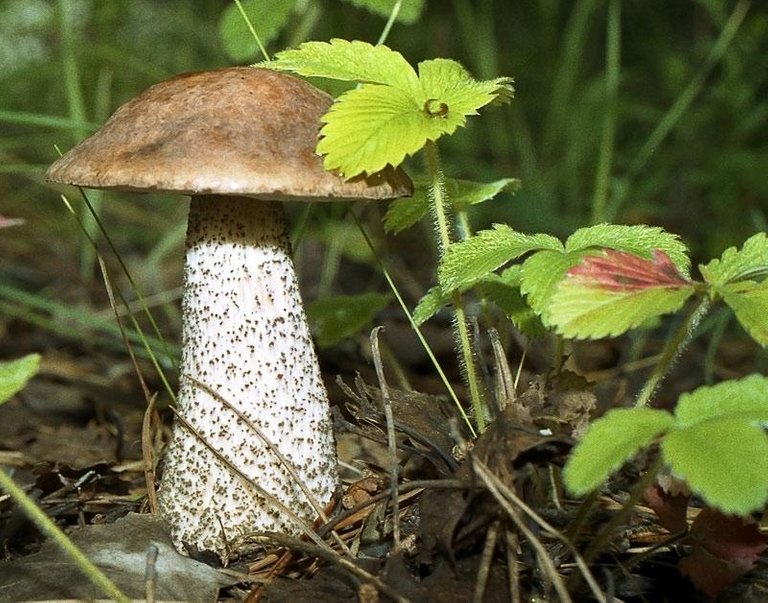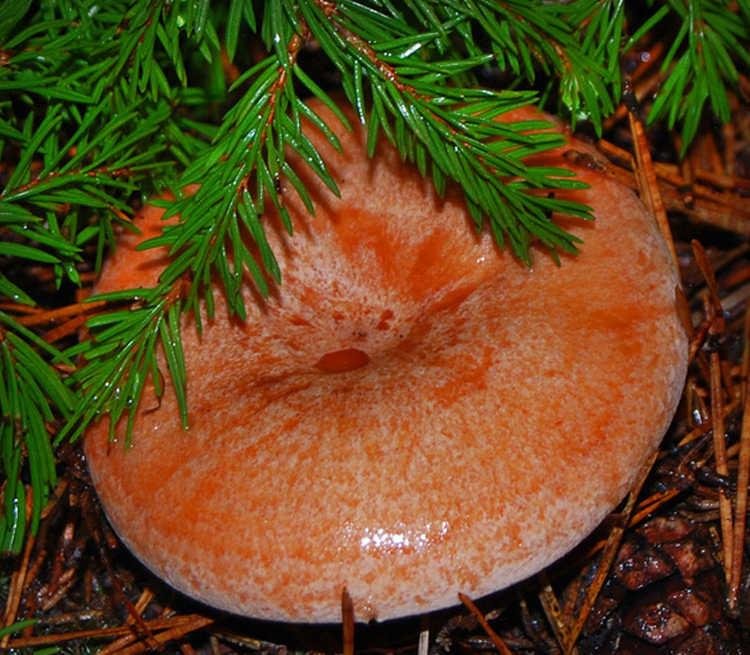All the good days and good mood!
Autumn came, in September a great time, the nature changes its color, and in the woods full of mushrooms, about the most popular of them now, and let's talk!
Chanterelle.

Chanterelle - the best known and most common of the 60 species that make up the kind of Vulpecula (the family Lisichkovye).
At the fungus short (4-6 cm.), Smooth, slightly narrowed to the bottom of the leg. To the touch it dense.
Foot firmly fused with a hat. Young fungus "headpiece" almost flat with a curved edge. Over time, the cap takes the form of a funnel with irregular contours. The edges are ragged, torn in places. Rare branched psevdoplastinki pass from the inside surface of the cap on the leg. The diameter of the head - in the range of 4-6 cm.
All the fruit body chanterelle colored in light yellow or orange-yellow color. Often there are faded almost to white copies. Bright orange chanterelles are only overripe. It is better to pass by.
The flesh is dense fungus. Top yellowish, closer to the center - whitish. When the incision / cracked felt a faint fruity odor.
Chanterelle never Worms. Mushroom deters mosquitoes and flies hinomannoza, so they prefer to lay their eggs in other places. If by chance rot fungus, rot is a point always in sight. This feature saves from disappointments in the processing of the crop.
Chanterelle grows in mixed and deciduous forests. But the most actively growing in pine forests. These fungi prefer mossy ground. They are visible from far away, hidden in the grass not, settle in large groups.
Chanterelle - suitable for human consumption species. The fungus can boil, fry and pickle. Admissibility and freezing followed by 2-3-month storage in a refrigerator. Furthermore, this fungus is suitable for drying. Dried at a temperature of + 40 ° C Chanterelles should be stored in cloth packaging. Even repeatedly reduced in size, mushrooms retain bright colors. By the way, after falling into boiling water volumes are reduced. Calorie fresh mushrooms is 23 kcal per 100 g, dried in increases to 261 kcal / 100 g
Besides unconditional taste, this fungus possesses useful properties. In its high content of copper and zinc, vitamins A, PP, B1 and B2, as well as provitamin D.
Substance hinomannoza not only discourages forest insects, but also great fights worms. True, salted or heat treatment, it is destroyed. To expel parasites from the body to eat raw mushrooms, used as a condiment dried milled or purchase medicines from the extracts of Chanterelle.
Lactarius aspen.

Lactarius aspen - mushroom genus Russula Mlechnik family.
Cap 6-30 cm, very fleshy and thick, plano-convex and slightly depressed in the center, young mushrooms curved down slightly fuzzy edges. Then straighten the edges and often wavy. The skin is white or spotted by pink spots, covered with fine fuzz and wet weather quite sticky.
The flesh is whitish, thick and brittle, with a slight fruity flavor and quite spicy taste. Highlights abundant milky juice of white color, without changing the air, bitter.
Foot 3-8 cm in height, strong, short, very dense, and sometimes eccentric, often constricted at the base, white or pinkish.
The plates were frequent, rather narrow, sometimes forked and descending on the leg, cream or pale pink
Spore powder pink, Disputes 7 × 5 mm, nearly rounded, folded, venous, amyloid.
Conditionally edible mushroom, used mainly in salt form, rarely - fried or boiled in the second dishes. Valued less than the real agaric agaric and yellow.
Volnushki pink.

Volnushki pink - Mushroom Russula genus Mlechnik family.
The diameter of 5-10 cm (up to 15), pinkish-red, with dark concentric zones, in his youth a convex, then flat, dents in the center, with a wrapped down downy edges. Myakost white or light cream, brittle, weak resinous smell, on a break allocates white acrid juice.
The Russian Related edible mushroom of good quality, is used in salted and pickled, sometimes fresh in the second dishes. Especially appreciated in Zasole young mushrooms (with Diamer cap no more than 3-4 cm), the so-called "curls". Before cooking requires a thorough soaking and blanching. The blanks yellow.
Along with Lactarius flexuosus penny and this is a basic mushrooms, procured the population of the north for the winter. The ratio of the workpieces varies depending on the yield, but most predominate volnushki.
In Central and Southern Europe in the food do not eat. In Finland, by contrast, after 5-10 minutes of blanching, even fried.
Suillus.

Suillus - kind of tubular edible mushrooms Maslёnkovye family included in the order Boletovye.
A hat from a convex shape to a flat, smooth, usually sticky or slimy, easy to peel. Perhaps the presence of the private covers.
Hymenophore easily separated from the cap; adherent or downward on the stem, yellow or white.
Stem solid, smooth or grainy, sometimes with a ring - the remnants of the private covers.
The flesh is whitish or yellowish, on the cut can change the color to blue or red.
Spore print different shades of yellow.
According to the content of fats and carbohydrates ahead of boletus mushrooms.
Suillus luteus - One of the most common types of edible mushrooms, in its productivity has been ranked in the coniferous forests.
Edible, tasty mushroom second category, in taste is very close to the white mushrooms. Before use, the skin better with the cap removed.
It is used in dried, fresh, pickled and salted.
Orange-cap boletus.

Since all aspen mushrooms are edible and almost identical in nutritional qualities, mushroom pickers do not always distinguish between their views. However, mushroom hunting is useful to know the environmental features of different kinds.
The name "boletus" are connected not only with the typical habitats of these fungi, but also with the color of hats, reminiscent of autumn colored aspen leaves.
Cap diameter 4-15 (rarely up to 30) cm, initially hemispherical with a tightly pressed against the edge of the leg, then cushion-convex shape, is easily separated from the stem. The skin is red, orange or brownish-red, smooth and velvety with a weak, can not be removed.
The flesh is meaty, dense, elastic in a hat, with age becomes soft in the leg longitudinal fibrous. The color white on the cut in the bottom of the bluish legs, quickly becomes blue and then black. Taste and smell are not expressed.
Red aspen forest
The tubular layer of loose, white, then it becomes brownish-gray, maybe with olive or yellowish tinge. Duct lengths of 1 - 3 cm with small angular-rounded pores, the porous surface of the touch dark.
Leg height of 5-15 cm, a thickness of 1.5-5 cm, a solid, often in the lower part is expanded. The surface of the gray-white, covered with longitudinal fibrous scales, they are white at first, becoming brownish with age.
Spore print is olive-brown spores (13-17) × (4-5) mm, smooth, fusiform.
Well-known edible mushroom, many put it in second place after the quality of the white mushroom.
Use fresh (boiled and fried), dried and pickled species for salting. When processing is usually dark, but in the marinade keeps the natural look. To prevent or reduce the darkening of the fungus before cooking soaked in a 0.5% solution of citric acid.
Podberёzovik.

At boletus cap can vary from light gray to dark brown (color depends, obviously, on the growing conditions and the type of wood, which formed mycorrhiza). Form - hemispherical, then Pillow, naked or fine-felt, up to 15 cm in diameter, in wet weather a little slimy. The flesh is white, does not change color or slightly turning pink, with a pleasant "mushroom" smell and taste. The old mushroom flesh is very spongy, watery.
Normal edible mushroom. In some (Western) sources indicate that only edible hats and legs allegedly too hard. Absurd! Cooked just different hats nauseating gelatinous consistency, while the legs are always Kripen'ka collected.
The only thing that all reasonable people agree - is that in older mushrooms tubular layer must be removed. (And, ideally, to refer back to the forest.)
Saffron milk cap.

Ginger is well distinguished from other fungi.
Cap 3 - 15 cm in diameter, tolstomyasistaya flat at the beginning, then funnel-shaped, the edges are wrapped inside the smooth, slightly slimy, red or whitish-orange color with darker concentric circles (variety - upland saffron) or orange with a clear bluish-green tone and the same concentric circles (a type - spruce saffron), the touch is colored greenish-blue color.
Ginger - edible mushroom of the first category.
Used mostly for salting and pickling, but you can use it and fried.
For drying unsuitable.
Before salting mushrooms should not be soaked, as they can go green and turn black, even, enough to clear them from the trash and rinse in cold water.
From this release Ryzhik laktarioviolin antibiotic that inhibits growth of many bacteria, including Mycobacterium tuberculosis.
Choose the right mushrooms and will arrive with you health!
Please vote for the post, if you like it, thank you very much in advance !!!!!!!!
Thanks 4 sharing this
Very Informative